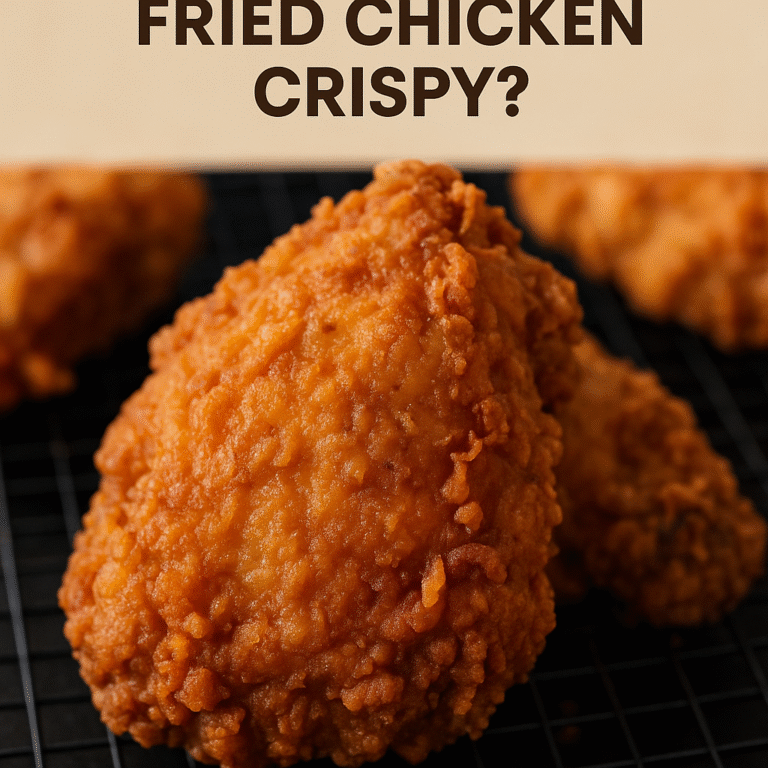What Makes Fried Chicken Crispy ?
Fried chicken is one of the most loved comfort foods around the world. A perfectly fried piece of chicken is juicy on the inside, with a golden-brown, crunchy crust on the outside. But what exactly makes fried chicken crispy? The secret lies in a combination of the right ingredients, cooking techniques, and temperatures. In this detailed guide, we’ll explore the science and culinary art behind creating that satisfying crunch.
1. The Importance of the Chicken Skin
Natural Fat and Texture
The chicken skin plays a major role in creating a crispy exterior. It contains a layer of fat that renders out during frying, leaving behind a paper-thin, crunchy shell. Skin-on chicken tends to retain more moisture while allowing the surface to become crispy.
2. Marination: The Initial Phase of Texture and Flavor
Brine with Buttermilk
A classic method is to soak chicken in buttermilk. Buttermilk’s acids and enzymes assist tenderize meat by slightly breaking down proteins and improving the meat’s ability to retain the flour coating on the outside.
Seasoned Marinades
By properly penetrating the seasoning, adding salt, spices, or even a little vinegar to the marinade enhances flavor and encourages crispy skin.
Natural Texture and Fat
A crispy exterior is largely due to the chicken skin. It has a coating of fat that renders away when it’s fried, leaving behind a crunchy, paper-thin shell. Skin-on chicken allows the skin to get crispy while retaining more moisture.
3. Selecting Bone-In vs. Boneless Chicken Cuts
Bone-in chicken parts, such as wings, drumsticks, and thighs, are frequently preferred for crispy fried chicken. These cuts maintain their juicy texture during frying, which enables the coating to crisp up without the meat becoming dry.
Thickness Is Important
Crispiness may be impacted by thicker pieces taking longer to cook. Even frying and crispness are ensured by balancing thickness.
4. The Breading Method: Flour Base, Flour, Cornstarch, and Spices
The most popular substrate for the crispy coating is all-purpose flour. It produces a golden brown, textured surface that fries well.
Boost from Cornstarch
The crispiness is improved by incorporating a small amount of cornstarch into the flour mixture. Because cornstarch contains less gluten, it absorbs less oil, resulting in a crust that is lighter and crispier.
Dredging twice
Some cooks employ the double dredge method, which involves dipping the chicken in flour, buttermilk, and flour again for added crunch. In hot oil, this creates coating layers that puff and crisp.
5. Seasoning the Coating: It’s Important to Use Spices
In addition to adding flavor to the fried chicken, adding garlic powder, onion powder, paprika, cayenne, salt, and pepper to the flour mixture also produces a richly colored, textured crust.
Wet versus Dry Breading
Wet batters, such as eggs or buttermilk, produce a thick, crispy shell, while dry breading, which only uses flour and spices, produces a light, flaky crust.

conclusion
Tossing meat into heated oil is only one aspect of the crispy enchantment of fried chicken; other factors include technique, ingredients, and attention to detail. Every step adds to that signature crunch, from choosing the ideal chicken slices and breading mix to perfecting oil temperature and resting techniques. Knowing these components enables you to make delicious fried chicken that is crispy on the exterior and tender on the inside, whether you’re a home cook or a restaurant chef.It’s time to give crispy fried chicken a try now that you know its secrets. You will always achieve the ideal crunch with practice!
